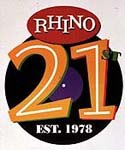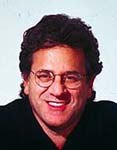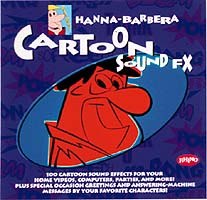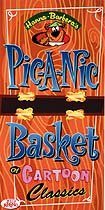Conceived with a sense of humor and a love for music and pop culture, Rhino Records has followed its quirky sensibility right into the heart of cartoon culture. Sharon Schatz profiles this successful venture.

Ever hear the kazoo version of Led Zeppelin's `Whole Lotta Love?' Ever listen to "The World's Worst Records" album and actually had to use the barf bag that comes with it? Well, me neither, but it's no surprise that the same record label who released these offbeat tunes is the same company to embrace the wacky cartoon theme songs with which we all grew up. Conceived with a sense of humor and a love for music and pop culture, Rhino Records was founded in 1978 by Richard Foos and Harold Bronson. Sharing the same quirky sensibility, the two created what has become the best recorded archive of popular music and culture. Their unique company, whose mission statement includes the phrase "have some fun," is about more than just silly songs from the past.

The History
It all began in the early `70s. Foos, a recent college graduate, bought $3 worth of used records and sold them out of the trunk of his car. His profits proved he wasn't the only one who appreciated old records and he soon opened Rhino Records, a retail store specializing in vintage vinyl, in Westwood, a section of Los Angeles. Foos hired Bronson, a store regular who shared his love of music and fun. Together, with no real business plan they created a hip and quirky record store that developed a cult following.
The Rhino label was born when Foos and Bronson recorded local street eccentric Wild Man Fischer's screechy promotional song, `Go to Rhino Records,' on a Panasonic recorder in the back of the store. Soon after, they released their first album, Fischer's "Wildmania." After producing several more novelty records, the two built their business by re-releasing and repackaging music from other companies. They created compilations, reissues, and "best of" albums including music of every genre from the `20s to the present. As their image changed to include high quality in addition to their quirkiness, Rhino reverted back to its "wacky" roots by adding animation music and theme songs to its repertoire.

Kid Rhino
In 1991, Rhino Entertainment founded Kid Rhino to create and market audio entertainment for kids and their families. Carol Lee, Vice President of Kid Rhino comments, "I think there was always an interest from the Rhino side of the business in developing a children's label. As the business grew, Rhino realized that if they were really going to compete within the kids' marketplace, the music needed to be associated with some very strong licenses in the kids' world."
The Licensors
Doing what they do best, Kid Rhino decided that the way to approach the children's market was to tap into children's pop culture. Hanna-Barbera was one of Kid Rhino's early licensors and their first release was "A Christmas in Bedrock," featuring original songs sung by The Flintstones characters. The album's success led to additional releases including "Hanna-Barbera Classics," which features cartoon scores from Huckleberry Hound, Quick Draw McGraw, Magilla Gorilla, and other early Hanna-Barbera series. The label also released The Flintstones' "Modern Stone-Age Melodies," the "Hanna-Barbera Cartoon Sound FX" library, which includes cartoon sound effects and answering machine messages in the characters' voices, and a 4-CD box set called "Hanna-Barbera's Pic-A-Nic Basket of Cartoon Classics."

Some of the label's most successful properties come from Cartoon Network. The recently released "Cartoon Network's Cartoon Medley" features 38 songs including the themes from The Powerpuff Girls, Dexter's Laboratory, Johnny Bravo, and old favorites like The Flintstones, The Jetsons, and Josie & the Pussycats. According to Lee, "Scooby-Doo's Snack Treats: The Ultimate Collection" has been Kid Rhino's most successful animation album, mainly due to its broad appeal. She says, "...The babyboomers remember [Scooby Doo] from when they were growing up and want to share it with their kids...and it's playing on Cartoon Network, so a new audience is able to learn about it." The album features the different Scooby Doo theme songs and the catchy tunes played during those memorable chase scenes. Licensing from Nickelodeon, Kid Rhino released "The Best of Nicktoons," which features music from Rugrats, Ren & Stimpy, Rocko's Modern Life, and Angry Beavers. Plus, two of the newer Nickelodeon albums, "Rugrats: In Search of the Mighty Reptar" and "Blues Clues: Blue's Big Treasure" feature both stories and music.

The company also licensed music from ABC Television and produced the Schoolhouse Rock albums. In addition, they've produced several albums within the anime genre, licensing the songs from various Japanese companies. These albums include "The Best of Anime" (including theme songs from Speed Racer and Gigantor) and "Sailor Moon: Songs from the Hit TV Series." Warner Brothers Rhino was acquired by Warner Music Group in April 1998. All of their Warner Brothers audio properties are released under Kid's WB! Music, an additional label developed by Rhino and Warner Brothers Consumer Products in 1996. The Animaniacs album was the first release, which includes 16 original songs from the series. "Animaniacs: Yakko's World" soon followed. Looney Tunes albums include "Looney Tunes: Bugs & Friends Sing Elvis," "Baby Looney Tunes: Born to Sing," which features 20 Mother Goose parody songs, and "Looney Tunes: Taz in a Scary Tale From Down Under," a read-along. Lee says working with Warner Brothers gives the company an advantage: "...We become aware of properties they're going to be putting out on home video, theatricals, and television.... Sometimes we'll go to them or they'll come to us and suggest that we develop something, which is what happened with The Iron Giant."

The Iron Giant Soundtrack
James Austin, Senior Director of A&R (Artists & Repetoire)/Special Projects for Rhino, worked as the music supervisor for The Iron Giant film and soundtrack. The soundtrack is a Rhino release (versus Kid Rhino) because of adult crossover appeal, but it was marketed by Kid Rhino. Since the movie takes place in the `50s, music from the era was the logical choice. When choosing music for the soundtrack, Austin tried to pick songs that were kid-friendly. He explains, "So you cut out all the songs about `I lost my baby' and all that unrequited love stuff because a [kid] doesn't know what that's about." Instead, he chose lighter music that is simply fun in nature.Comparing his work on animation soundtracks to live-action movie soundtracks, Austin says, "There's a different approach and I think it's a lot looser....You can sort of take more liberties with the storyline because it's animation."
Not Just for Kids
Lee says that because Kid Rhino's animated releases are broad in appeal, there is an opportunity to sell to children, parents, and young adults. Andy Seagram, Assistant Manager of the original Rhino Records store (which is completely independent of the record label) agrees, "We've got a lot of folks coming in to buy [Kid Rhino's animated releases] for their children, their grandchildren, or even for themselves." Seagram says there is a tremendous amount of adult interest in some of the albums. "People come in here, they see the stuff, and say, `Oh my God, I remember this from when I was a kid,' and they buy it," he explains, "They didn't even know this stuff still existed and they see it and they just go wild over it." Seagram claims the Schoolhouse Rock albums fall into this category.The Secret of Their Success According to Lee, Kid Rhino's strategy behind the animated releases is capitalizing on properties with which a consumer is already familiar. She says this works because, "...There's an awareness and a stamp of approval that the brands have established and it's enabled us to have success in the kids' marketplace because we're just putting out another form of entertainment."This formula has proven successful for Kid Rhino and the plan is to continue in the same vein. Lee says the company is trying to develop a larger presence for the Kid Rhino brand and that the future of the company goes hand in hand with the direction the licensors choose to take.

The company has also found that creating special packaging for their products has called attention to them. "Cartoon Network's Cartoon Medley" also comes with a CD-ROM component that includes games. "Blue's Clues: Blue's Big Treasure" includes a Colorforms playboard and play pieces. "Hanna-Barbera's Pic-A-Nic Basket of Cartoon Classics" box set looks like a picnic basket and includes a 33-page book about Hanna-Barbera's history. "We're trying very hard to differentiate ourselves and add value for the consumer by creating packages that are not [just a] straight record, because we want it to be perceived as a form of entertainment/toy....It can entertain you not only in a way that you can listen, but...you can play along, so to speak," Lee explains, "There's more than the music..." Sounds like Foos' and Bronson's passion and ideals have remained intact. From barf bag to picnic basket, Rhino still wants to have fun.Sharon Schatz works in the programming department at Fox Family Channel and is a freelance writer based in Los Angeles. She has a special appreciation for Schoolhouse Rock and often starts her day with a few tracks from "America Rock." She has also been known to blast `Josie & the Pussycats' on her car stereo while driving in rush hour traffic.







